CHCECE005 - Provide Care for Babies and Toddlers: Knowledge Assessment
VerifiedAdded on 2022/12/27
|22
|3842
|1
Homework Assignment
AI Summary
This document presents a completed knowledge assessment for the CHCECE005 unit, focusing on providing care for babies and toddlers. The assessment covers key areas including SUDI (Sudden Unexpected Death in Infants) safe sleep practices, with descriptions of ten safe sleep practices and infection control strategies for linen and mattresses. It also explores brain development, including true/false statements, strategies to support healthy brain development, and the concept of serve and return interactions. Furthermore, the assessment delves into nappy changing, toilet training, and hygiene, referencing the Education and Care National Regulations and identifying the responsibilities of an Approved Provider. The assessment is designed to evaluate the student's understanding of these crucial aspects of early childhood education and care, ensuring the physical and emotional wellbeing of babies and toddlers.
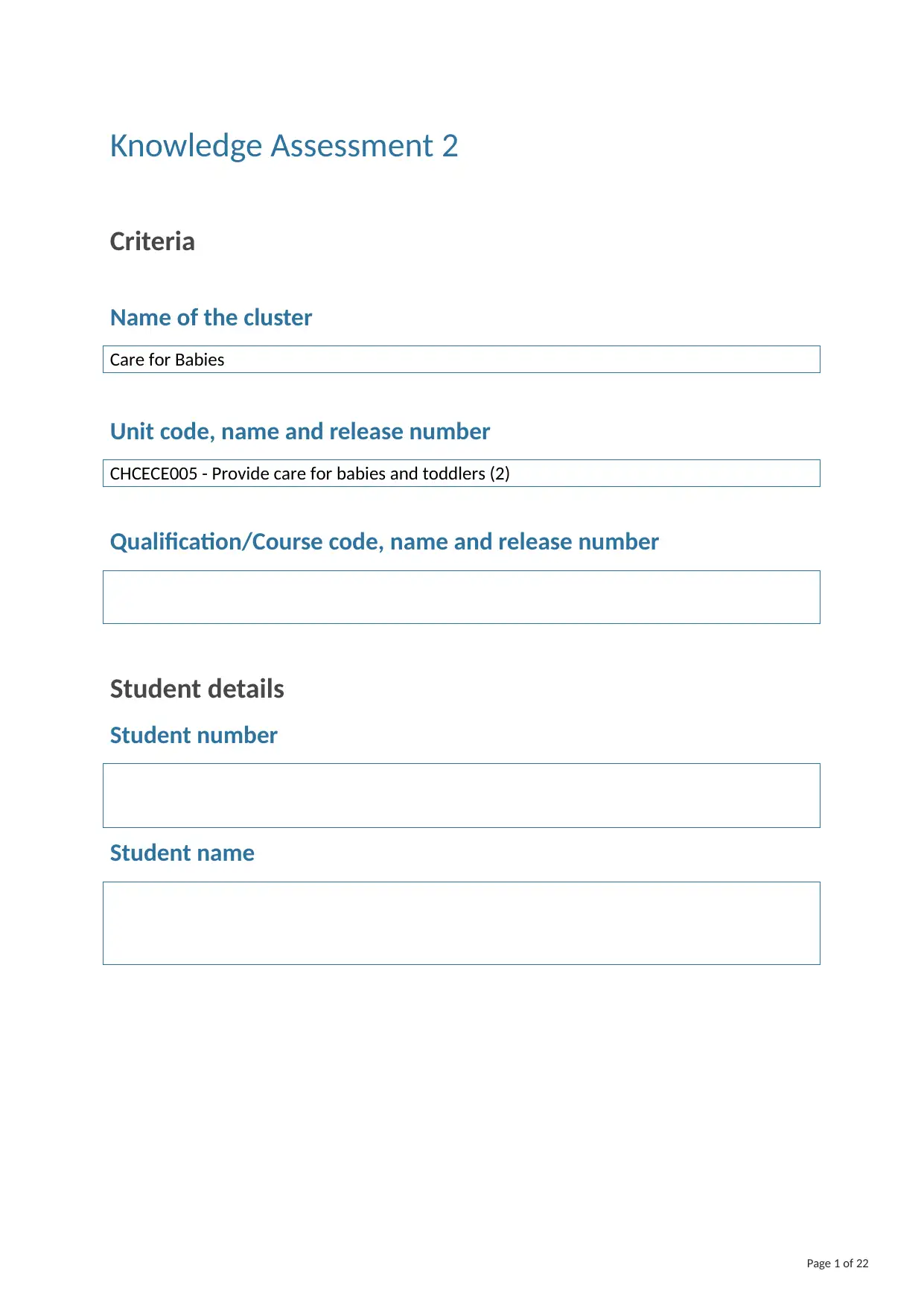
Knowledge Assessment 2
Criteria
Name of the cluster
Care for Babies
Unit code, name and release number
CHCECE005 - Provide care for babies and toddlers (2)
Qualification/Course code, name and release number
Student details
Student number
Student name
Page 1 of 22
Criteria
Name of the cluster
Care for Babies
Unit code, name and release number
CHCECE005 - Provide care for babies and toddlers (2)
Qualification/Course code, name and release number
Student details
Student number
Student name
Page 1 of 22
Paraphrase This Document
Need a fresh take? Get an instant paraphrase of this document with our AI Paraphraser

Page 2 of 22

© 2019 TAFE NSW, Sydney
RTO Provider Number 90003 | CRICOS Provider Code: 00591E
This assessment can be found in the: Learning Bank
The contents in this document is copyright © TAFE NSW 2019, and should not be reproduced without the
permission of the TAFE NSW. Information contained in this document is correct at time of printing: 31 August
2024. For current information please refer to our website or your teacher as appropriate.
Page 3 of 22
RTO Provider Number 90003 | CRICOS Provider Code: 00591E
This assessment can be found in the: Learning Bank
The contents in this document is copyright © TAFE NSW 2019, and should not be reproduced without the
permission of the TAFE NSW. Information contained in this document is correct at time of printing: 31 August
2024. For current information please refer to our website or your teacher as appropriate.
Page 3 of 22
⊘ This is a preview!⊘
Do you want full access?
Subscribe today to unlock all pages.

Trusted by 1+ million students worldwide
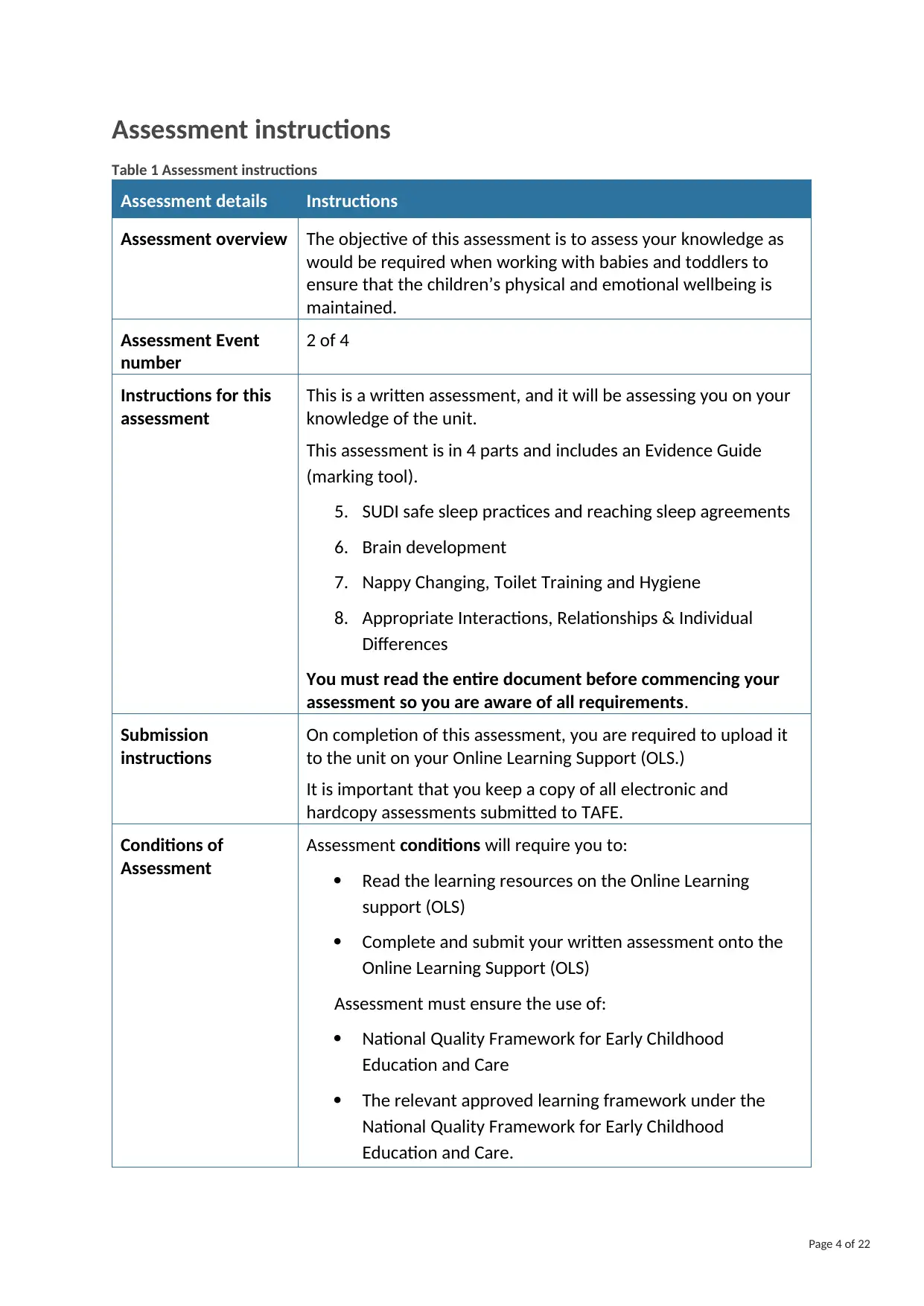
Assessment instructions
Table 1 Assessment instructions
Assessment details Instructions
Assessment overview The objective of this assessment is to assess your knowledge as
would be required when working with babies and toddlers to
ensure that the children’s physical and emotional wellbeing is
maintained.
Assessment Event
number
2 of 4
Instructions for this
assessment
This is a written assessment, and it will be assessing you on your
knowledge of the unit.
This assessment is in 4 parts and includes an Evidence Guide
(marking tool).
5. SUDI safe sleep practices and reaching sleep agreements
6. Brain development
7. Nappy Changing, Toilet Training and Hygiene
8. Appropriate Interactions, Relationships & Individual
Differences
You must read the entire document before commencing your
assessment so you are aware of all requirements.
Submission
instructions
On completion of this assessment, you are required to upload it
to the unit on your Online Learning Support (OLS.)
It is important that you keep a copy of all electronic and
hardcopy assessments submitted to TAFE.
Conditions of
Assessment
Assessment conditions will require you to:
Read the learning resources on the Online Learning
support (OLS)
Complete and submit your written assessment onto the
Online Learning Support (OLS)
Assessment must ensure the use of:
National Quality Framework for Early Childhood
Education and Care
The relevant approved learning framework under the
National Quality Framework for Early Childhood
Education and Care.
Page 4 of 22
Table 1 Assessment instructions
Assessment details Instructions
Assessment overview The objective of this assessment is to assess your knowledge as
would be required when working with babies and toddlers to
ensure that the children’s physical and emotional wellbeing is
maintained.
Assessment Event
number
2 of 4
Instructions for this
assessment
This is a written assessment, and it will be assessing you on your
knowledge of the unit.
This assessment is in 4 parts and includes an Evidence Guide
(marking tool).
5. SUDI safe sleep practices and reaching sleep agreements
6. Brain development
7. Nappy Changing, Toilet Training and Hygiene
8. Appropriate Interactions, Relationships & Individual
Differences
You must read the entire document before commencing your
assessment so you are aware of all requirements.
Submission
instructions
On completion of this assessment, you are required to upload it
to the unit on your Online Learning Support (OLS.)
It is important that you keep a copy of all electronic and
hardcopy assessments submitted to TAFE.
Conditions of
Assessment
Assessment conditions will require you to:
Read the learning resources on the Online Learning
support (OLS)
Complete and submit your written assessment onto the
Online Learning Support (OLS)
Assessment must ensure the use of:
National Quality Framework for Early Childhood
Education and Care
The relevant approved learning framework under the
National Quality Framework for Early Childhood
Education and Care.
Page 4 of 22
Paraphrase This Document
Need a fresh take? Get an instant paraphrase of this document with our AI Paraphraser
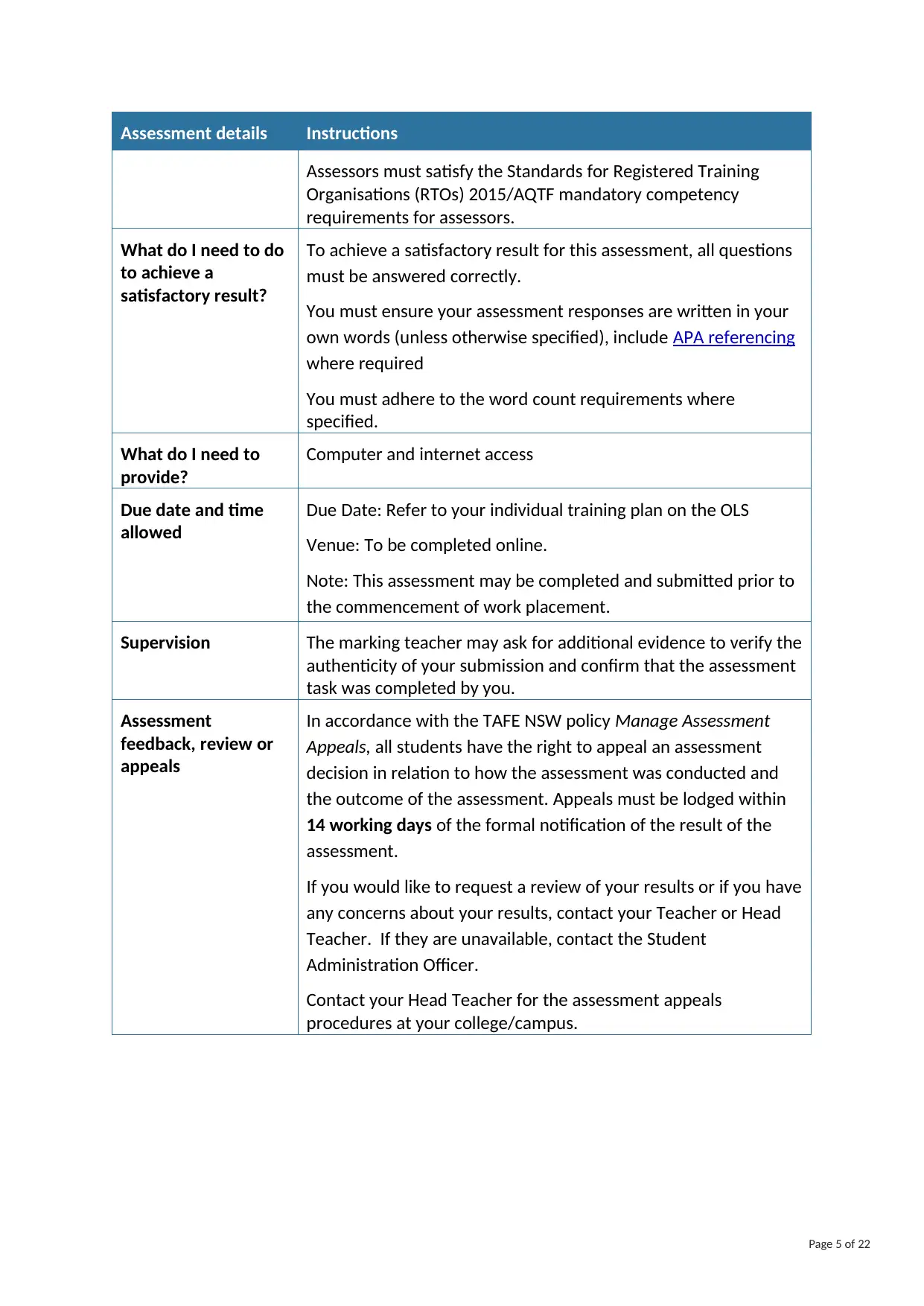
Assessment details Instructions
Assessors must satisfy the Standards for Registered Training
Organisations (RTOs) 2015/AQTF mandatory competency
requirements for assessors.
What do I need to do
to achieve a
satisfactory result?
To achieve a satisfactory result for this assessment, all questions
must be answered correctly.
You must ensure your assessment responses are written in your
own words (unless otherwise specified), include APA referencing
where required
You must adhere to the word count requirements where
specified.
What do I need to
provide?
Computer and internet access
Due date and time
allowed
Due Date: Refer to your individual training plan on the OLS
Venue: To be completed online.
Note: This assessment may be completed and submitted prior to
the commencement of work placement.
Supervision The marking teacher may ask for additional evidence to verify the
authenticity of your submission and confirm that the assessment
task was completed by you.
Assessment
feedback, review or
appeals
In accordance with the TAFE NSW policy Manage Assessment
Appeals, all students have the right to appeal an assessment
decision in relation to how the assessment was conducted and
the outcome of the assessment. Appeals must be lodged within
14 working days of the formal notification of the result of the
assessment.
If you would like to request a review of your results or if you have
any concerns about your results, contact your Teacher or Head
Teacher. If they are unavailable, contact the Student
Administration Officer.
Contact your Head Teacher for the assessment appeals
procedures at your college/campus.
Page 5 of 22
Assessors must satisfy the Standards for Registered Training
Organisations (RTOs) 2015/AQTF mandatory competency
requirements for assessors.
What do I need to do
to achieve a
satisfactory result?
To achieve a satisfactory result for this assessment, all questions
must be answered correctly.
You must ensure your assessment responses are written in your
own words (unless otherwise specified), include APA referencing
where required
You must adhere to the word count requirements where
specified.
What do I need to
provide?
Computer and internet access
Due date and time
allowed
Due Date: Refer to your individual training plan on the OLS
Venue: To be completed online.
Note: This assessment may be completed and submitted prior to
the commencement of work placement.
Supervision The marking teacher may ask for additional evidence to verify the
authenticity of your submission and confirm that the assessment
task was completed by you.
Assessment
feedback, review or
appeals
In accordance with the TAFE NSW policy Manage Assessment
Appeals, all students have the right to appeal an assessment
decision in relation to how the assessment was conducted and
the outcome of the assessment. Appeals must be lodged within
14 working days of the formal notification of the result of the
assessment.
If you would like to request a review of your results or if you have
any concerns about your results, contact your Teacher or Head
Teacher. If they are unavailable, contact the Student
Administration Officer.
Contact your Head Teacher for the assessment appeals
procedures at your college/campus.
Page 5 of 22

Knowledge Assessment Specific Task Instructions
Introduction: This task outlines the Knowledge Evidence and Assessment Conditions your
assessor will be marking you on for Provide Care for Babies and Toddlers.
This knowledge assessment will require you to apply your knowledge of the following:
5. SUDI safe sleep practices and reaching sleep agreements
6. Brain development
7. Nappy Changing, Toilet Training and Hygiene
8. Appropriate Interactions, Relationships & Individual Differences
Your knowledge of the areas above will be assessed through a range of questions including
Multiple Choice, True or False, Agree or Disagree and Short Answer responses.
When: The knowledge assessment will take place according to the date and time on your
training plan. The knowledge assessment may be undertaken in a single session or broken
into sections with each section of the knowledge assessment conducted after the related
content topic for the unit.
Where: The assessment task will be completed digitally using a computer for online
submissions. A due date by which students must complete the assessment will be according
to the individual student training plan.
How will the task be assessed?
Each part of the knowledge assessment will have instructions that guide you on the criteria
for answering each type of question. Evidence will be collected through your responses at
the completion of the task.
The following tasks will need to be completed in full. You cannot leave questions
incomplete.
Why am I doing this task?
All the criteria must be met. Your knowledge evidence will be used as part of the overall
evidence requirements of the unit. You must achieve competency in all the assessable tasks
to satisfactorily complete the unit.
Page 6 of 22
Introduction: This task outlines the Knowledge Evidence and Assessment Conditions your
assessor will be marking you on for Provide Care for Babies and Toddlers.
This knowledge assessment will require you to apply your knowledge of the following:
5. SUDI safe sleep practices and reaching sleep agreements
6. Brain development
7. Nappy Changing, Toilet Training and Hygiene
8. Appropriate Interactions, Relationships & Individual Differences
Your knowledge of the areas above will be assessed through a range of questions including
Multiple Choice, True or False, Agree or Disagree and Short Answer responses.
When: The knowledge assessment will take place according to the date and time on your
training plan. The knowledge assessment may be undertaken in a single session or broken
into sections with each section of the knowledge assessment conducted after the related
content topic for the unit.
Where: The assessment task will be completed digitally using a computer for online
submissions. A due date by which students must complete the assessment will be according
to the individual student training plan.
How will the task be assessed?
Each part of the knowledge assessment will have instructions that guide you on the criteria
for answering each type of question. Evidence will be collected through your responses at
the completion of the task.
The following tasks will need to be completed in full. You cannot leave questions
incomplete.
Why am I doing this task?
All the criteria must be met. Your knowledge evidence will be used as part of the overall
evidence requirements of the unit. You must achieve competency in all the assessable tasks
to satisfactorily complete the unit.
Page 6 of 22
⊘ This is a preview!⊘
Do you want full access?
Subscribe today to unlock all pages.

Trusted by 1+ million students worldwide
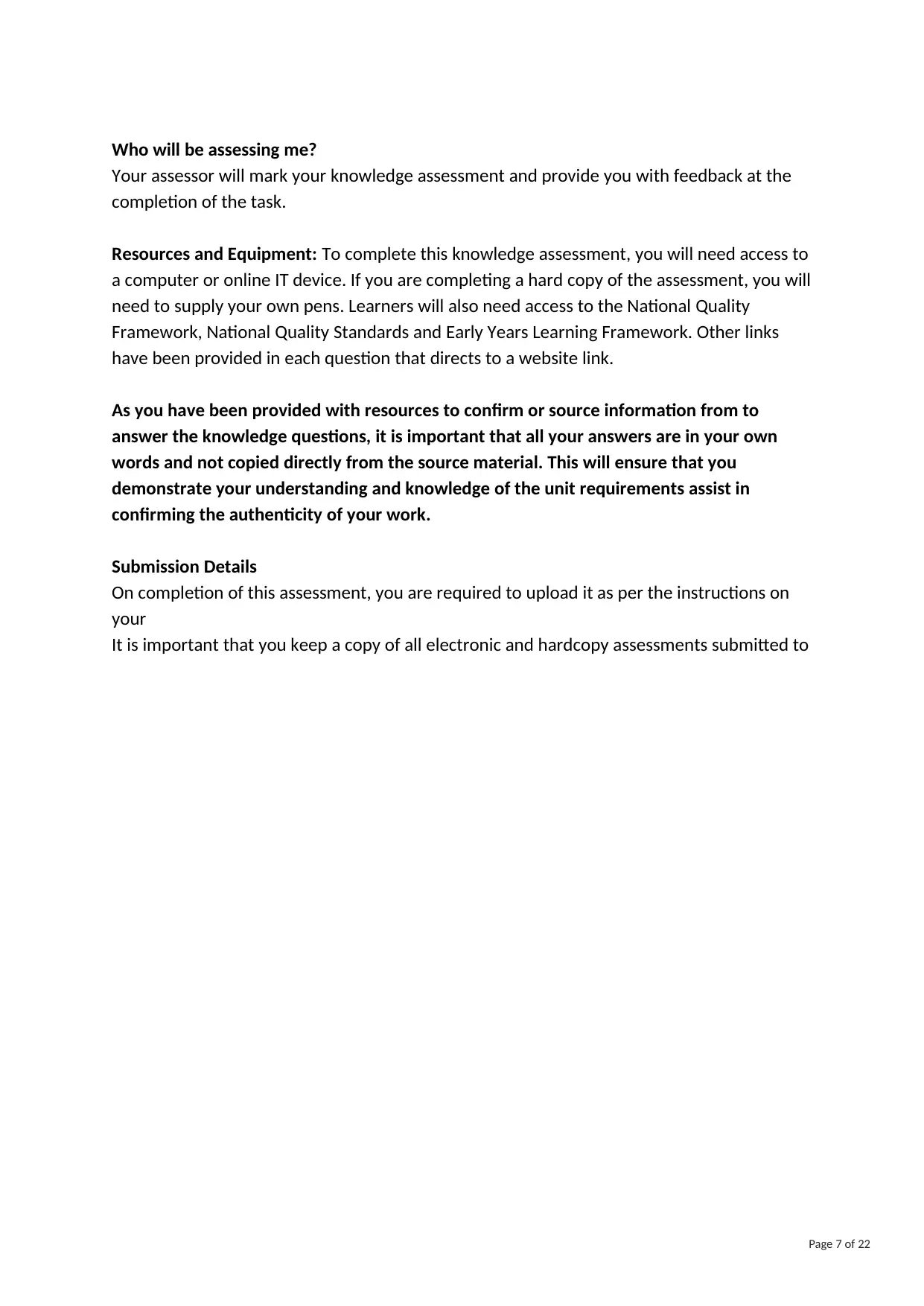
Who will be assessing me?
Your assessor will mark your knowledge assessment and provide you with feedback at the
completion of the task.
Resources and Equipment: To complete this knowledge assessment, you will need access to
a computer or online IT device. If you are completing a hard copy of the assessment, you will
need to supply your own pens. Learners will also need access to the National Quality
Framework, National Quality Standards and Early Years Learning Framework. Other links
have been provided in each question that directs to a website link.
As you have been provided with resources to confirm or source information from to
answer the knowledge questions, it is important that all your answers are in your own
words and not copied directly from the source material. This will ensure that you
demonstrate your understanding and knowledge of the unit requirements assist in
confirming the authenticity of your work.
Submission Details
On completion of this assessment, you are required to upload it as per the instructions on
your
It is important that you keep a copy of all electronic and hardcopy assessments submitted to
Page 7 of 22
Your assessor will mark your knowledge assessment and provide you with feedback at the
completion of the task.
Resources and Equipment: To complete this knowledge assessment, you will need access to
a computer or online IT device. If you are completing a hard copy of the assessment, you will
need to supply your own pens. Learners will also need access to the National Quality
Framework, National Quality Standards and Early Years Learning Framework. Other links
have been provided in each question that directs to a website link.
As you have been provided with resources to confirm or source information from to
answer the knowledge questions, it is important that all your answers are in your own
words and not copied directly from the source material. This will ensure that you
demonstrate your understanding and knowledge of the unit requirements assist in
confirming the authenticity of your work.
Submission Details
On completion of this assessment, you are required to upload it as per the instructions on
your
It is important that you keep a copy of all electronic and hardcopy assessments submitted to
Page 7 of 22
Paraphrase This Document
Need a fresh take? Get an instant paraphrase of this document with our AI Paraphraser

Part 5: Sudden Unexplained Death of Infants Safe Sleep
Practices and Reaching Sleep Agreements
1. Describe ten SUDI SAFE practices you will check or follow at sleep time and why.
(100-150 words)
SUDI SAFE sleeping practices Why is this
recommended?
1. Keep baby on back It provide relaxed position
to baby
2. Baby sleep must be in a safe cot It help to offer required
safety
3. The head and face of baby is uncovered It assist to take fresh air
4. Baby must have safe environment for sleeping In this baby felt more
comfort and calm.
5. Breastfeed the baby It provide required
nutrition and offer
supportive development
and growth
6. Baby must be kept free from smoke area In this baby is free from
any chemical inhaling.
7. Adequate bond is maintained with baby It offer adequate support
and safety
8. Provide comfort and convenient space to baby In this required space is
provided so that baby felt
more comfort
9. Quick response is offered to baby For this easy accessibility
and suitable connection is
developed in between
parents and baby.
10. Eliminating hazard by providing soft pillow and bumper It assist to provide a
Page 8 of 22
Practices and Reaching Sleep Agreements
1. Describe ten SUDI SAFE practices you will check or follow at sleep time and why.
(100-150 words)
SUDI SAFE sleeping practices Why is this
recommended?
1. Keep baby on back It provide relaxed position
to baby
2. Baby sleep must be in a safe cot It help to offer required
safety
3. The head and face of baby is uncovered It assist to take fresh air
4. Baby must have safe environment for sleeping In this baby felt more
comfort and calm.
5. Breastfeed the baby It provide required
nutrition and offer
supportive development
and growth
6. Baby must be kept free from smoke area In this baby is free from
any chemical inhaling.
7. Adequate bond is maintained with baby It offer adequate support
and safety
8. Provide comfort and convenient space to baby In this required space is
provided so that baby felt
more comfort
9. Quick response is offered to baby For this easy accessibility
and suitable connection is
developed in between
parents and baby.
10. Eliminating hazard by providing soft pillow and bumper It assist to provide a
Page 8 of 22
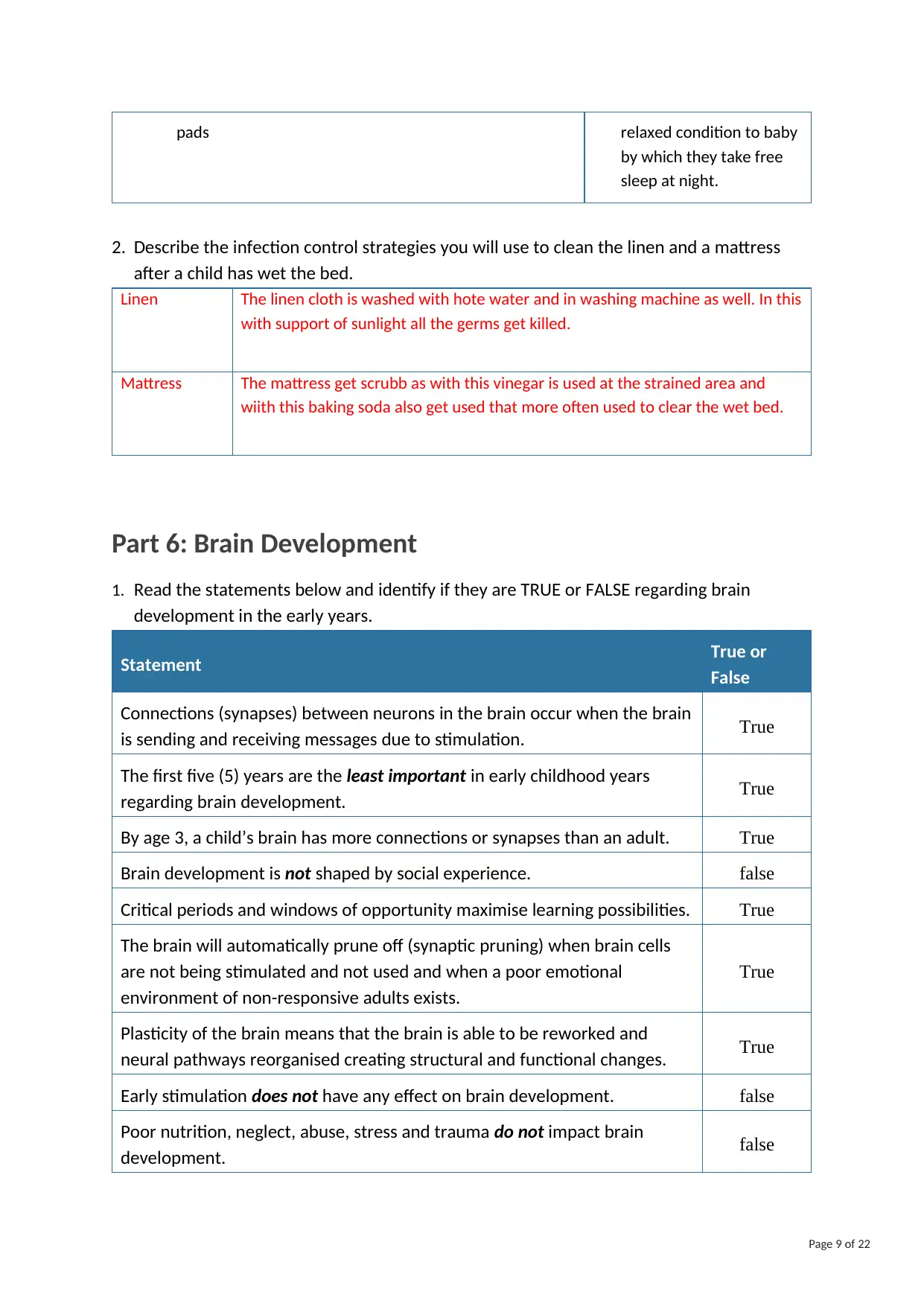
pads relaxed condition to baby
by which they take free
sleep at night.
2. Describe the infection control strategies you will use to clean the linen and a mattress
after a child has wet the bed.
Linen The linen cloth is washed with hote water and in washing machine as well. In this
with support of sunlight all the germs get killed.
Mattress The mattress get scrubb as with this vinegar is used at the strained area and
wiith this baking soda also get used that more often used to clear the wet bed.
Part 6: Brain Development
1. Read the statements below and identify if they are TRUE or FALSE regarding brain
development in the early years.
Statement True or
False
Connections (synapses) between neurons in the brain occur when the brain
is sending and receiving messages due to stimulation. True
The first five (5) years are the least important in early childhood years
regarding brain development. True
By age 3, a child’s brain has more connections or synapses than an adult. True
Brain development is not shaped by social experience. false
Critical periods and windows of opportunity maximise learning possibilities. True
The brain will automatically prune off (synaptic pruning) when brain cells
are not being stimulated and not used and when a poor emotional
environment of non-responsive adults exists.
True
Plasticity of the brain means that the brain is able to be reworked and
neural pathways reorganised creating structural and functional changes. True
Early stimulation does not have any effect on brain development. false
Poor nutrition, neglect, abuse, stress and trauma do not impact brain
development. false
Page 9 of 22
by which they take free
sleep at night.
2. Describe the infection control strategies you will use to clean the linen and a mattress
after a child has wet the bed.
Linen The linen cloth is washed with hote water and in washing machine as well. In this
with support of sunlight all the germs get killed.
Mattress The mattress get scrubb as with this vinegar is used at the strained area and
wiith this baking soda also get used that more often used to clear the wet bed.
Part 6: Brain Development
1. Read the statements below and identify if they are TRUE or FALSE regarding brain
development in the early years.
Statement True or
False
Connections (synapses) between neurons in the brain occur when the brain
is sending and receiving messages due to stimulation. True
The first five (5) years are the least important in early childhood years
regarding brain development. True
By age 3, a child’s brain has more connections or synapses than an adult. True
Brain development is not shaped by social experience. false
Critical periods and windows of opportunity maximise learning possibilities. True
The brain will automatically prune off (synaptic pruning) when brain cells
are not being stimulated and not used and when a poor emotional
environment of non-responsive adults exists.
True
Plasticity of the brain means that the brain is able to be reworked and
neural pathways reorganised creating structural and functional changes. True
Early stimulation does not have any effect on brain development. false
Poor nutrition, neglect, abuse, stress and trauma do not impact brain
development. false
Page 9 of 22
⊘ This is a preview!⊘
Do you want full access?
Subscribe today to unlock all pages.

Trusted by 1+ million students worldwide
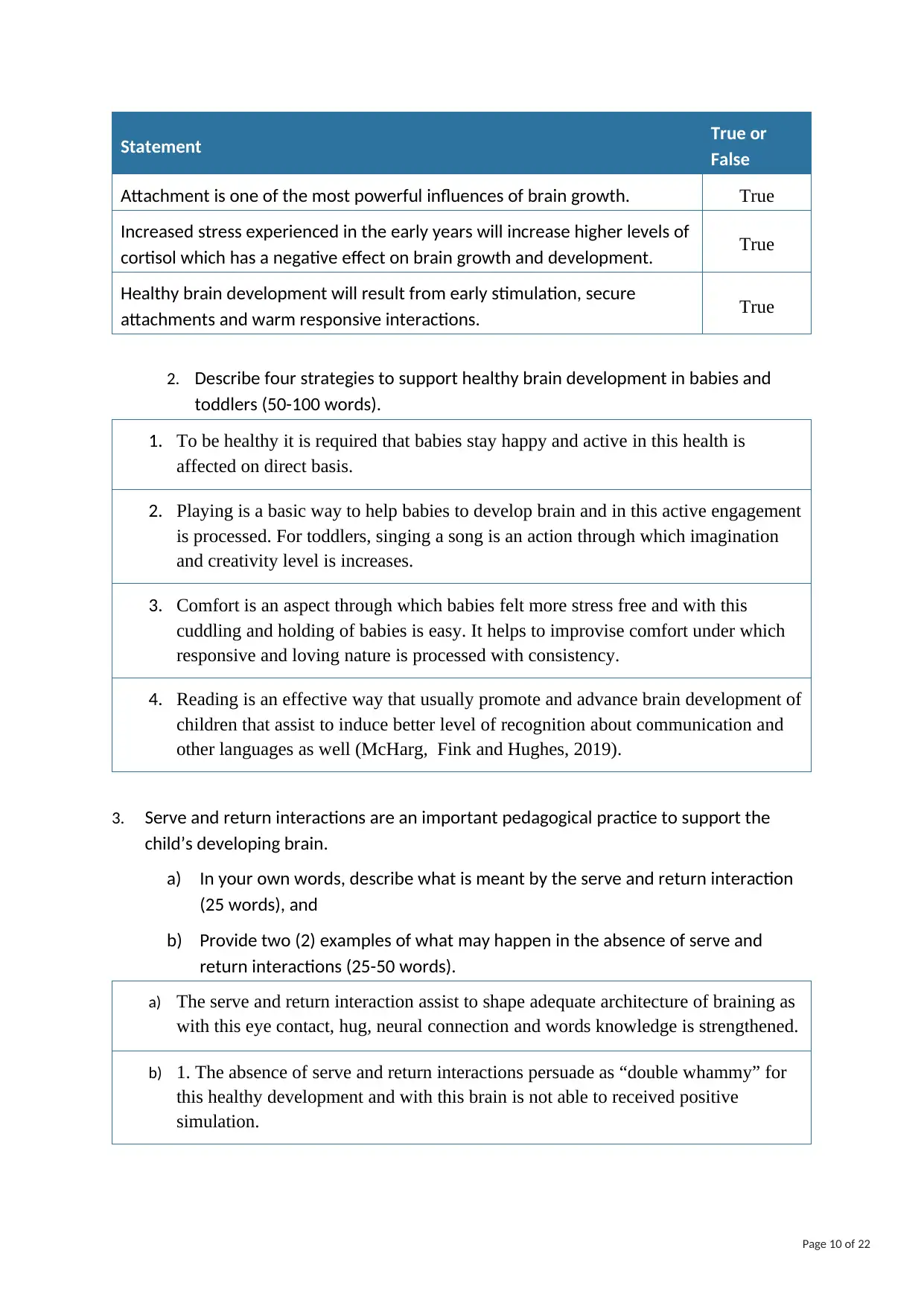
Statement True or
False
Attachment is one of the most powerful influences of brain growth. True
Increased stress experienced in the early years will increase higher levels of
cortisol which has a negative effect on brain growth and development. True
Healthy brain development will result from early stimulation, secure
attachments and warm responsive interactions. True
2. Describe four strategies to support healthy brain development in babies and
toddlers (50-100 words).
1. To be healthy it is required that babies stay happy and active in this health is
affected on direct basis.
2. Playing is a basic way to help babies to develop brain and in this active engagement
is processed. For toddlers, singing a song is an action through which imagination
and creativity level is increases.
3. Comfort is an aspect through which babies felt more stress free and with this
cuddling and holding of babies is easy. It helps to improvise comfort under which
responsive and loving nature is processed with consistency.
4. Reading is an effective way that usually promote and advance brain development of
children that assist to induce better level of recognition about communication and
other languages as well (McHarg, Fink and Hughes, 2019).
3. Serve and return interactions are an important pedagogical practice to support the
child’s developing brain.
a) In your own words, describe what is meant by the serve and return interaction
(25 words), and
b) Provide two (2) examples of what may happen in the absence of serve and
return interactions (25-50 words).
a) The serve and return interaction assist to shape adequate architecture of braining as
with this eye contact, hug, neural connection and words knowledge is strengthened.
b) 1. The absence of serve and return interactions persuade as “double whammy” for
this healthy development and with this brain is not able to received positive
simulation.
Page 10 of 22
False
Attachment is one of the most powerful influences of brain growth. True
Increased stress experienced in the early years will increase higher levels of
cortisol which has a negative effect on brain growth and development. True
Healthy brain development will result from early stimulation, secure
attachments and warm responsive interactions. True
2. Describe four strategies to support healthy brain development in babies and
toddlers (50-100 words).
1. To be healthy it is required that babies stay happy and active in this health is
affected on direct basis.
2. Playing is a basic way to help babies to develop brain and in this active engagement
is processed. For toddlers, singing a song is an action through which imagination
and creativity level is increases.
3. Comfort is an aspect through which babies felt more stress free and with this
cuddling and holding of babies is easy. It helps to improvise comfort under which
responsive and loving nature is processed with consistency.
4. Reading is an effective way that usually promote and advance brain development of
children that assist to induce better level of recognition about communication and
other languages as well (McHarg, Fink and Hughes, 2019).
3. Serve and return interactions are an important pedagogical practice to support the
child’s developing brain.
a) In your own words, describe what is meant by the serve and return interaction
(25 words), and
b) Provide two (2) examples of what may happen in the absence of serve and
return interactions (25-50 words).
a) The serve and return interaction assist to shape adequate architecture of braining as
with this eye contact, hug, neural connection and words knowledge is strengthened.
b) 1. The absence of serve and return interactions persuade as “double whammy” for
this healthy development and with this brain is not able to received positive
simulation.
Page 10 of 22
Paraphrase This Document
Need a fresh take? Get an instant paraphrase of this document with our AI Paraphraser

b) 2. The body starts response actively and it resulted into potential harm to stress
hormones.
Page 11 of 22
hormones.
Page 11 of 22
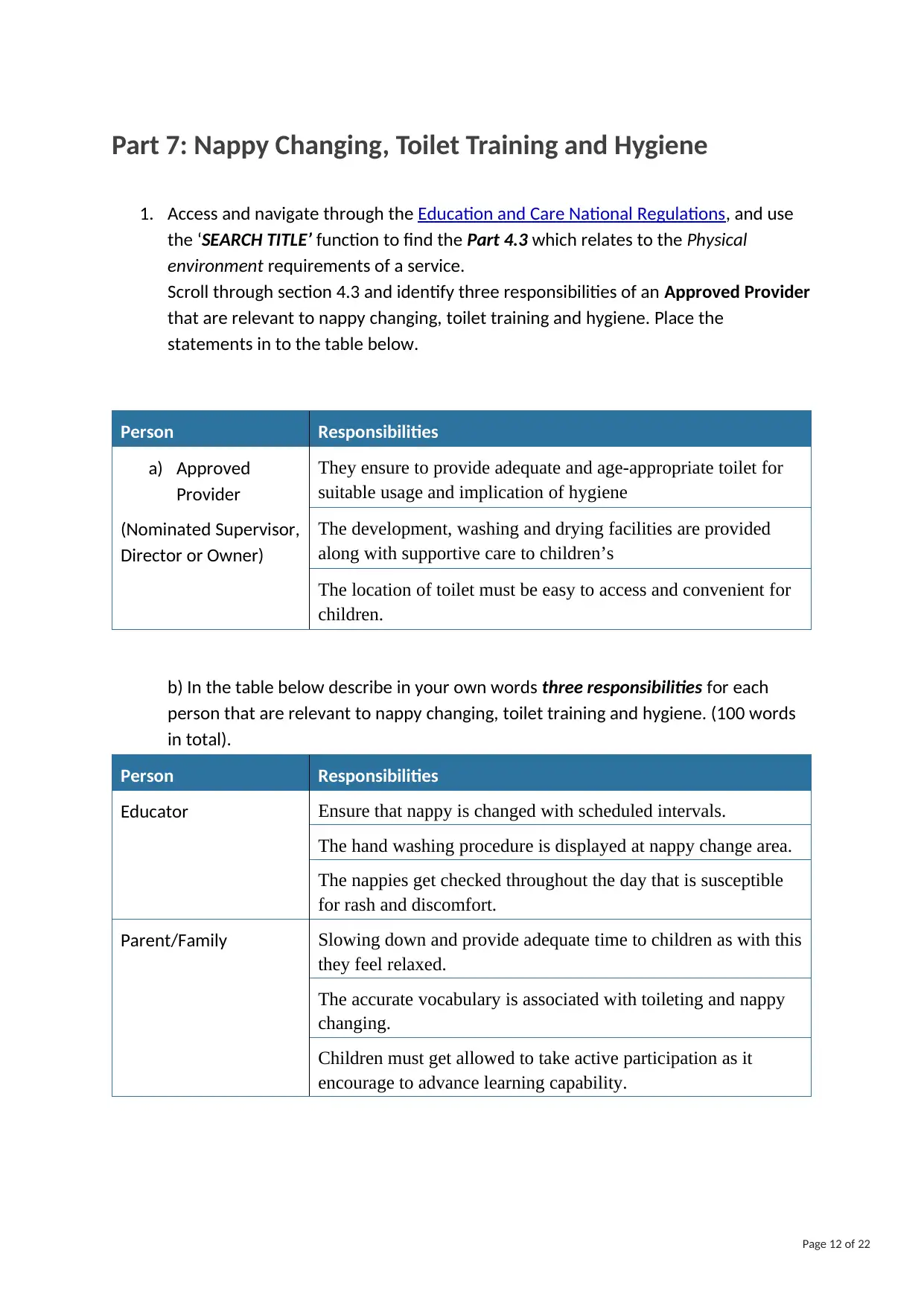
Part 7: Nappy Changing, Toilet Training and Hygiene
1. Access and navigate through the Education and Care National Regulations, and use
the ‘SEARCH TITLE’ function to find the Part 4.3 which relates to the Physical
environment requirements of a service.
Scroll through section 4.3 and identify three responsibilities of an Approved Provider
that are relevant to nappy changing, toilet training and hygiene. Place the
statements in to the table below.
Person Responsibilities
a) Approved
Provider
(Nominated Supervisor,
Director or Owner)
They ensure to provide adequate and age-appropriate toilet for
suitable usage and implication of hygiene
The development, washing and drying facilities are provided
along with supportive care to children’s
The location of toilet must be easy to access and convenient for
children.
b) In the table below describe in your own words three responsibilities for each
person that are relevant to nappy changing, toilet training and hygiene. (100 words
in total).
Person Responsibilities
Educator Ensure that nappy is changed with scheduled intervals.
The hand washing procedure is displayed at nappy change area.
The nappies get checked throughout the day that is susceptible
for rash and discomfort.
Parent/Family Slowing down and provide adequate time to children as with this
they feel relaxed.
The accurate vocabulary is associated with toileting and nappy
changing.
Children must get allowed to take active participation as it
encourage to advance learning capability.
Page 12 of 22
1. Access and navigate through the Education and Care National Regulations, and use
the ‘SEARCH TITLE’ function to find the Part 4.3 which relates to the Physical
environment requirements of a service.
Scroll through section 4.3 and identify three responsibilities of an Approved Provider
that are relevant to nappy changing, toilet training and hygiene. Place the
statements in to the table below.
Person Responsibilities
a) Approved
Provider
(Nominated Supervisor,
Director or Owner)
They ensure to provide adequate and age-appropriate toilet for
suitable usage and implication of hygiene
The development, washing and drying facilities are provided
along with supportive care to children’s
The location of toilet must be easy to access and convenient for
children.
b) In the table below describe in your own words three responsibilities for each
person that are relevant to nappy changing, toilet training and hygiene. (100 words
in total).
Person Responsibilities
Educator Ensure that nappy is changed with scheduled intervals.
The hand washing procedure is displayed at nappy change area.
The nappies get checked throughout the day that is susceptible
for rash and discomfort.
Parent/Family Slowing down and provide adequate time to children as with this
they feel relaxed.
The accurate vocabulary is associated with toileting and nappy
changing.
Children must get allowed to take active participation as it
encourage to advance learning capability.
Page 12 of 22
⊘ This is a preview!⊘
Do you want full access?
Subscribe today to unlock all pages.

Trusted by 1+ million students worldwide
1 out of 22
Related Documents
Your All-in-One AI-Powered Toolkit for Academic Success.
+13062052269
info@desklib.com
Available 24*7 on WhatsApp / Email
![[object Object]](/_next/static/media/star-bottom.7253800d.svg)
Unlock your academic potential
Copyright © 2020–2025 A2Z Services. All Rights Reserved. Developed and managed by ZUCOL.




